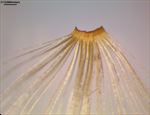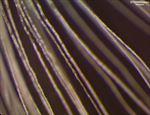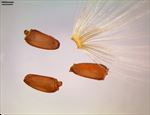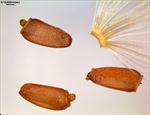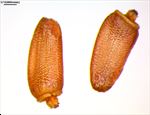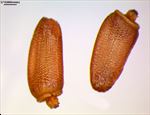Taxonomy
Carduus nutans L., Sp. Pl. 2:821. 1753Common synonyms
Carduus armenus Boiss.; Carduus coloratus (C.Winkl.) Tamamsch.; Carduus leiophyllus var. vestitus Hallier in Hallier; Carduus nutans f. nutans; Carduus nutans var. armenus Boiss.; Carduus nutans var. leiophyllus; Carduus nutans var. nutans; Carduus nutans var. phyllolepis (Willk.) Rivas Mart., T.E.Díaz, Fern.Prieto, Loidi & Penas; Carduus nutans var. songaricus C.Winkl.; Carduus nutans var. songaricus C.Winkl. ex O.Fedtsch. & B.Fedtsch.; Carduus nutans var. vestitus (Hallier) B.Boivin; Carduus phyllolepis Willk.; Carduus schischkinii Tamamsch.; Carduus songoricus (C.Winkl. ex C.Winkl.) Tamamsch.; Saussurea colorata C.Winkl.
Common name
Nodding thistle, musk thistle
Description
Propagule or dispersal unit is the fruit with pappus. Fertile part 2.5-4 mm long, 1.4-1.6 mm wide, in side view widest in upper part (obovoid), +/- straight, rarely conspicuously curved, the upper (apical) end narrowing, in cross-section flattened, basal scar (carpopodium) inconspicuous and undifferentiated, central, beak (=thinner sterile stalk between seed and pappus) absent, wings absent, fruit surface light brown or straw, smooth (except at cellular level) or wrinkled, with no hairs (glabrous), thickened margin absent, longitudinal ribs absent.
Pappus type bristles / hairs, pappus elements all +/- similar, up to 12-20 mm long, in several rows, pappus elements numerous, falling off as a whole, the individual bristles rough / serrated (barbellate), +/- equal width along length, white / translucent, rarely brown.
Ecology
Large annual to biennial herb, with seeds dispersing poorly due to large size and deciduous pappus. Temperate regions. Found especially on pastures / paddocks, where lifestock avoid the spiny leaves and allow it to outcompete more palatable plants.
Native range
Europe, Tunisia?, temperate Asia from Caucasus to China, Korea?
Introduced range
Canada, United States, Uruguay?, Chile?, Argentina, Australia, New Zealand
